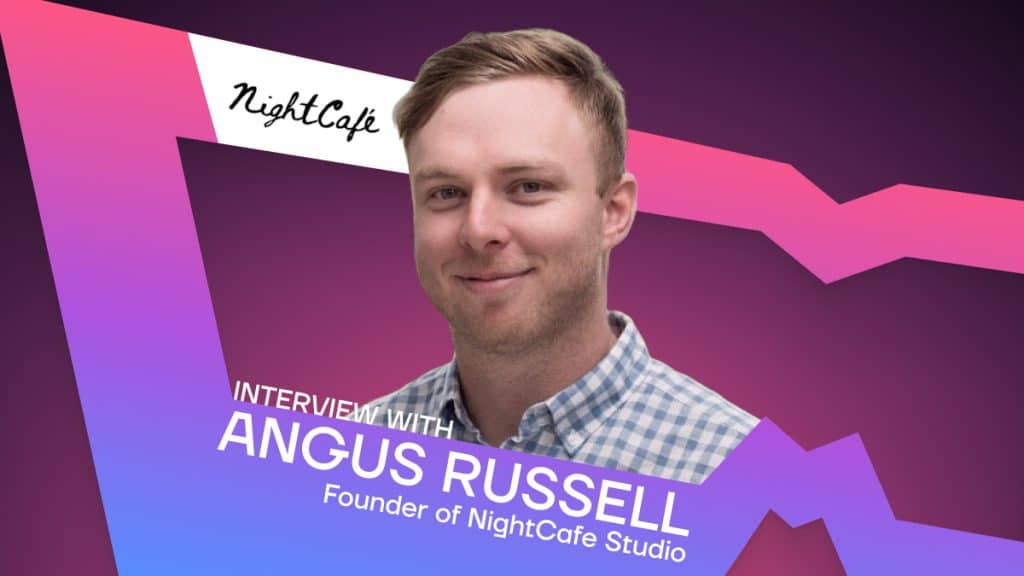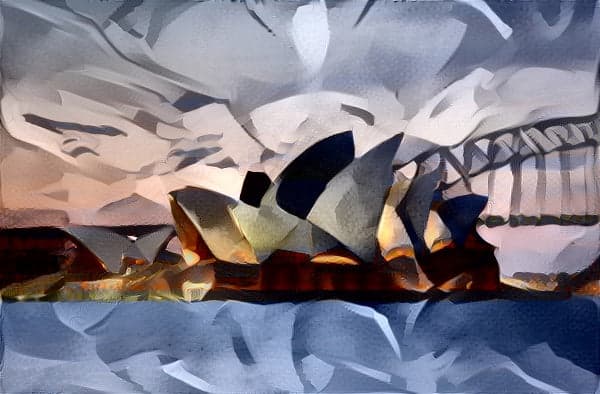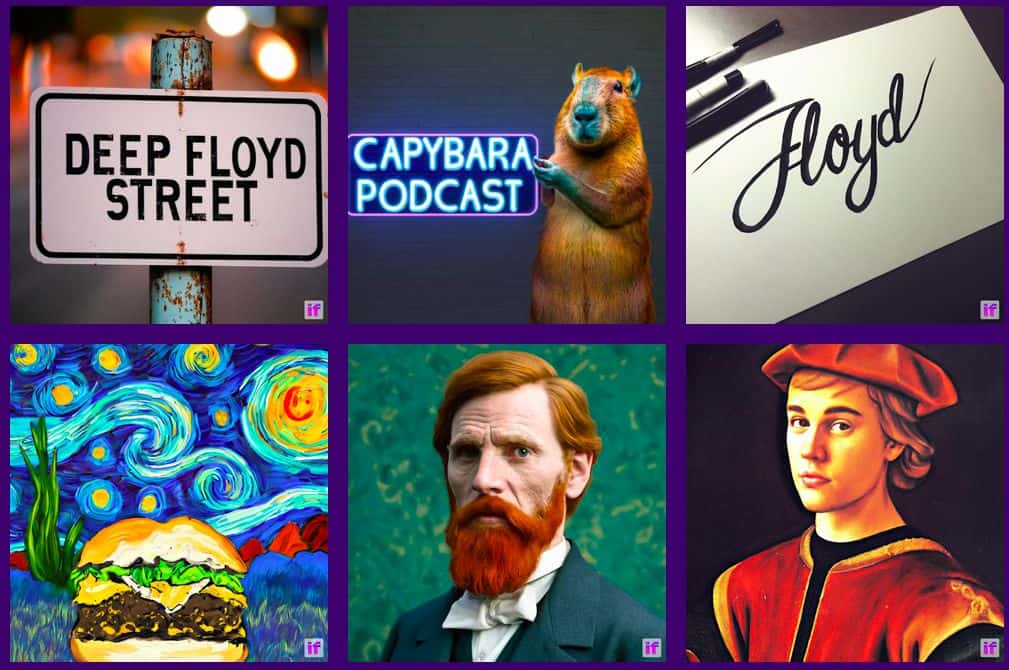Delving into AI Art Innovations: Insights from the CEO of NightCafe Studio
In Brief
In a special discussion, the CEO of NightCafe Studio shared intriguing insights and viewpoints on the world of AI-generated artistic creations.
Angus Russell introduced DeepFloyd, a cutting-edge algorithm born out of a collaboration with Stability AI, which operates within pixel space and employs a Large Language Model (LLM) to create imagery.

NightCafe Studio is a platform designed to empower users to craft breathtaking and forward-looking visual art quickly and efficiently through artificial intelligence. Founded by Angus Russell about four years back, NightCafe Studio emerged from Angus's own challenges in finding art that resonated with him. Recognizing the potential of style transfer algorithms, he sought a platform that would enable him to produce personalized art through these methods and even print them out.
To his dismay, he couldn't find a suitable service. Yet, this frustration ignited a spark of creativity within him. He decided to develop a neural style transfer app for producing AI art and shared it with the Reddit community.
NightCafe Studio started as a pioneering text-to-image platform, standing out as the first of its kind. This distinctive capability led to an impressive rise in both revenue and user engagement. Since then, the platform has consistently led the charge in generative AI, drawing a vibrant community of enthusiasts who delight in using the generator to produce exceptional artwork. Today, NightCafe Studio is viewed as one of the leading and most innovative AI image generation platforms available.
In my conversation with Angus Russell, we tapped into the pros and cons of AI in the art sector, the growing adoption of artificial intelligence in creative fields, and the newest AI image generation model, DeepFloyd.

The Emergence of AI-generated Art
Over the past decade, the art realm has gradually embraced AI and machine learning (ML) technologies. These modern innovations have introduced captivating new concepts like Deepfakes and others, which have garnered considerable global interest. At this point, the art industry must acknowledge the substantial influence of AI, which is instigating a long-awaited transformation within the sector. DALL-E Angus reflected on how NightCafe Studio experienced notable growth when launching a text-to-image model, which they unveiled on the very first day. Since that time, the barrier to entry for creating similar generative tools has diminished with the open-sourcing of algorithms and demonstration codes.
NightCafe's founder believes that the essence of AI art isn't solely in the final piece, but in the journey of creation itself. He perceives it as a therapeutic and relaxing pursuit, granting individuals a unique outlet to express their creativity. Numerous users, who might never have labeled themselves as creative, have unearthed their artistic talents through AI-generated images. This philosophy is mirrored in the platform's user-friendly design, thoughtfully crafted to accommodate artists at all proficiency levels. Stable Diffusion Currently, NightCafe Studio boasts an impressive monthly user base of two to three million, resulting in approximately a million images created each day. On the other hand, Stability AI—a company championing open-source generative AI—
reported having over 10 million active users on a daily basis shortly after rolling out Stable Diffusion.
Top AI Art Generators of 2023: Including Midjourney, DALL-E, NightCafe, and Artbreeder stated Introducing DeepFloyd IF: The Revolutionary New Algorithm for AI Image Generation
| Recommended: NightCafe Studio is set to integrate a groundbreaking algorithm developed by Stability AI called |
, which is poised to transform the methodology behind AI image creation.
Currently in beta, DeepFloyd represents a novel text-to-image model capable of producing remarkable visuals from natural language prompts. It boasts a unique framework that unites a large language model with a trio of diffusion models. This architecture takes inspiration from Google Research's Imagen, a similar model that was never made public. DeepFloyd The capacity of this model to generate clear, coherent images with text and objects arranged in various spatial contexts is a significant advancement, addressing a common hurdle present in many existing text-to-image generators. This is accomplished by employing the T5-XXL-1.1 language model as a text encoder, coupled with a substantial number of cross-attention layers between text and images that enhance their correlation.
DeepFloyd not only enables the creation of images with atypical aspect ratios but also achieves a high level of photorealism. Additionally, it offers zero-shot image-to-image conversion, which allows alterations of style, patterns, and finer details in an output image while retaining the core structure of the source material without requiring additional adjustments.
This new algorithm functions quite differently from
. While DeepFloyd works within pixel space and utilizes a Large Language Model (LLM), Stable Diffusion operates in latent space, relying on a preset CLIP model. Furthermore, DeepFloyd employs multiple diffusion methodologies to craft its images, contrasting with
DeepFloyd refers to the research group responsible for developing the algorithm, which is officially named IF. This group includes several individuals who played pivotal roles in the creation of both GPT-3’s predecessor, GPT-2, and the earlier groundbreaking language model, RuGPT. Stable Diffusion There's speculation that the name IF may draw inspiration from a Pink Floyd song of the same title, as indicated by hints in the social media bios of the algorithm's research team. Stable Diffusion only uses a single one.
Visuals yielded by DeepFloyd IF. Source: Stability AI
Evaluating the Boundaries of AI Art Versus Traditional Digital Art
Read more about the algorithm here .

cultural and societal nuances that shape human artistry
. Consequently, AI-produced artwork can occasionally result in pieces that feel out of context or culturally tone-deaf. Yet, as Angus pointed out, it’s entirely possible for AI-generated art to surpass the original intent, provided the user is open to discovering unexpected outcomes. Plus, there are mechanisms to adjust the output images through AI tools or programs like Photoshop
. While refining an image to perfection is a focus of ongoing investigation, significant advancements are on the horizon. Soon, we might attain full command over every nuance of an image. AI draws inspiration from the wealth of visual content and artworks available online—but only from the images it's been trained on. Different algorithms, including , DALL-E, and Stable Diffusion, are developed using varied data collections, thus influencing their performance on particular image types.
Recently, researchers have been exploring how eliminating low-quality images from training datasets could enhance AI outcomes. By discarding these lesser images, the resulting dataset might be more compact but of higher quality, leading to superior results without necessitating larger AI models or more expensive hardware. Angus mentioned that this method signifies a hopeful strategy for enriching the calibre of AI-related images without depending on more substantial and resource-demanding frameworks. Midjourney One issue lingering around AI's role in art is its potential to undermine the value of human artists who invest significant time and effort crafting their work, in stark contrast to AI's ability to produce art almost instantaneously. However, human art carries certain intangible qualities—such as emotional richness and depth—that may elude AI replication. NightCafe Studio emphasizes that AI's purpose extends beyond mere commercial artistry, focusing instead on the joy inherent in the creative journey.
"Human-made art will always hold a unique value as it encapsulates the dedication and skill of the artist, unlike AI-generated pieces that lack this intrinsic worth,\"
A pressing ethical concern regarding AI in art is the use of publicly accessible images for training algorithms that may not be owned by the company behind the AI development. While this scenario doesn’t currently breach any laws, it raises significant questions about consent and privacy. Companies devoted to open-source initiatives like OpenAI and DALL-E are striving to refine the ethical dimensions of this process, yet it remains a complex conversation. Future regulations might emerge concerning the utilization of imagery to train AI in artistic fields.
Despite these challenges, Angus maintains that AI's interaction with artistic creation isn't fundamentally different from how human artists might derive inspiration from each other's works. AI is equipped to recognize and remember various visual elements, akin to human cognitive processes. Ultimately, it's just exceptionally proficient at reconstructing these images from scratch.
Angus said.
Amy Zhang from Fireblocks discusses Blockchain, AI, and the Metaverse at the Hong Kong Web3 Festival 2023.
Scott Lawin, CEO of Candy Digital, shares insights on navigating the NFT landscape after the boom.
Read more:
Disclaimer
In line with the Trust Project guidelines NightCafe Studio serves as a cutting-edge AI Art Generator, enabling individuals to craft breathtaking and innovative artworks in mere seconds, all thanks to advanced artificial intelligence capabilities.







